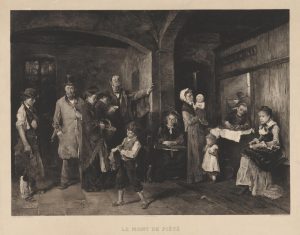
Le Mont de Piété (1885)
Etching, 48.6 x 61 cm (plate)
Gift of H.Koekkoek, 1889
National Gallery of Victoria (p.184.3-1)
Munkácsy, born in an area of the former Hungarian empire now in the Ukraine, achieved a substantial reputation for his genre and religious paintings, in Paris and elsewhere in later 19th-century Europe. Gerard Vaughan notes that wealthy local collector Frederick Armytage (1838-1912) owned several major paintings by Munkácsy, bought for large sums both in London and Melbourne, during the 1880s and 90s.
This print reproduces Munkácsy’s 1874 painting The Pawnbroker’s Shop; the title alludes to the type of institutional pawnbroker (in Italian, monte di pietà) first developed as a charitable institution during the Renaissance period to combat exorbitant money lending to the poor.
Koepping, identified in the inscription at lower right, also produced other etchings after Munkácsy. Bénézit observes that Koepping was also a noted Jugendstil glass-maker.
Refs.
AR 1889, p.44 (describing this print as an engraving); not listed in NGV 1894 or 1905
The NGV catalogue lists this as by an unknown artist after Munkácsy. For the 1874 painting, see e.g. http://www.mihalymunkacsy.org (complete list of the artist’s works); and for Munkácsy, see Bénézit 10, pp.47-48 and AKL 91 (2016), pp.274-75. For the institutional history, see e.g. Carol Bresnahan Menning, Charity and state in late Renaissance Italy: the monte di pieta of Florence, New York: Cornell University Press, 1993
For other prints by Koepping after Munkácsy, see e.g. https://www.metmuseum.org/art/collection/search#!/search?artist=Koepping,%20Charles$Charles%20Koepping; and for Koepping, see also Bénézit 7, p.1413 and AKL 81 (2014), pp.146-47. For F.W.Armytage’s collection of works by Munkácsy, see Vaughan, “Art collectors” (1976), Vol.I, pp.33ff., esp.38-39, and Vol.II, pp.39-41; see also http://adb.anu.edu.au/biography/armytage-frederick-william-29 (biography of F.W.Armytage and his brother Charles, by J.Ann Hone, first publ. in ADB vol.3, 1969)

